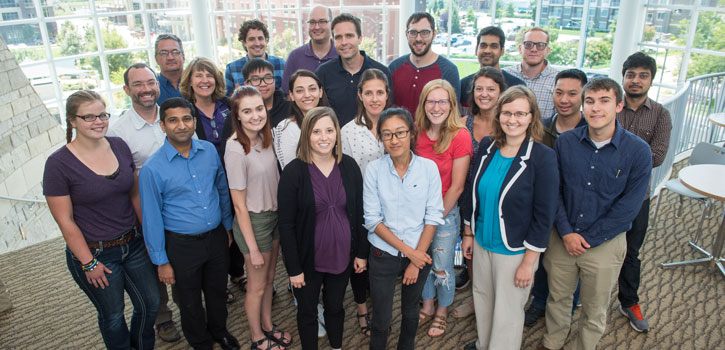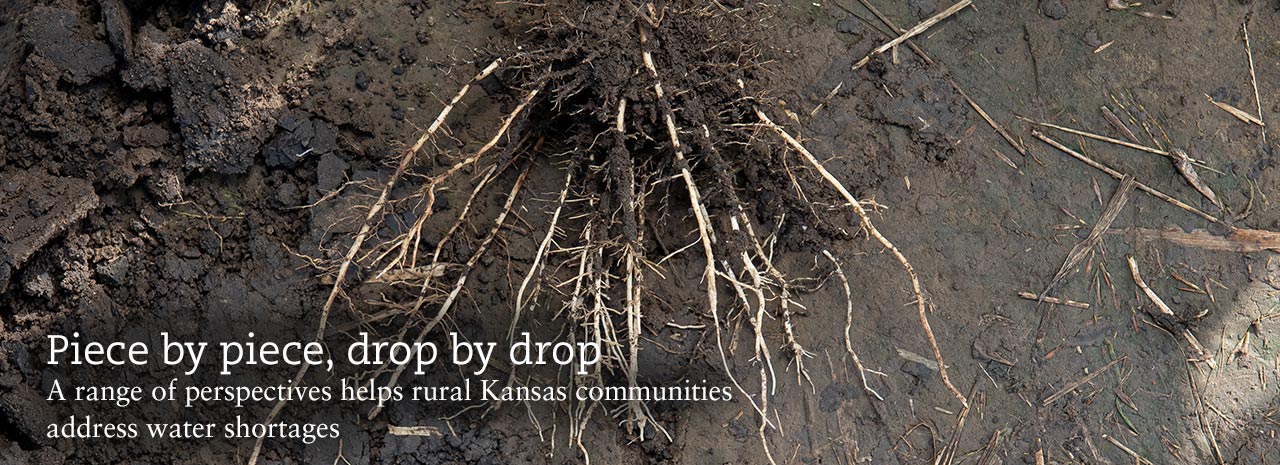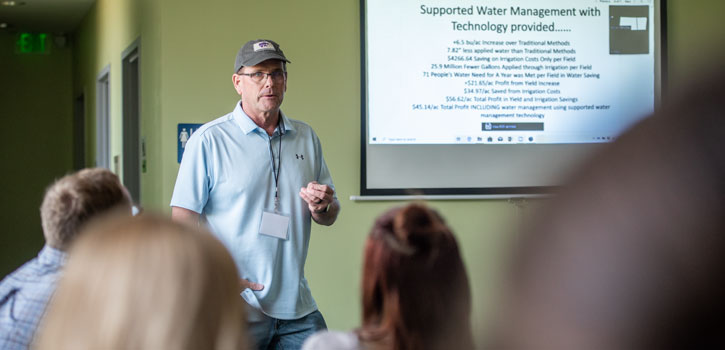Piece by piece, drop by drop: A range of perspectives helps rural Kansas communities address water shortages
By Mary Lou Peter
About the Ogallala Aquifer
The Ogallala Aquifer is a vast underground reservoir that underlies about 112 million acres under parts of Colorado, Kansas, Nebraska, New Mexico, Oklahoma, South Dakota, Texas and Wyoming. It is part of the High Plains Aquifer, the most abundant source of water in the region, but it is declining faster than it is replenishing.
Read the National Climate Assessment on the Ogallala Aquifer drying out.
Read a U.S. Geological Survey report that details how the High Plains Aquifer groundwater levels continue to decline.
Read Ogllala Aquifer information from the Kansas Department of Agriculture.
Some say great minds think alike, but bringing a diverse group of people together with different backgrounds, educational experiences and interests can result in even better solutions to big problems.
This is the idea behind a new Kansas State University effort that’s connecting researchers with a range of expertise to graduate students and communities in western Kansas. Together, they are addressing water shortages that threaten the agricultural economy, the lifeblood of those communities.
The five-year project is made possible by a $2.9 million National Science Foundation Research Traineeship, or NSF NRT, Program grant, which is the first ever awarded in Kansas. As part of the project, researchers in engineering, agricultural economics, sociology and communications are training 50 graduate students who are addressing such challenges as the declining Ogallala Aquifer and the implications for agriculture and affected communities.
Melanie Derby, associate professor in the Alan Levin Department of Mechanical and Nuclear Engineering, leads the project, which is in its first year. Her collaborators come from the Carl R. Ice College of Engineering, the College of Arts and Sciences, the College of Agriculture and K-State Research and Extension.
“Our aim is to create sustainable rural communities in western Kansas and beyond,” said Derby, also the Hal and Mary Siegele professor of engineering. “Our research focuses on engineering new technologies, such as water conservation, natural fertilizers with microbes, and reactors that transform animal waste into power. We are using economics and sociology to figure out how to create these technologies in a way that people will use them.”
The word interdisciplinary is used a lot in reference to the project: The researchers are creating interdisciplinary graduate classes in which the students conduct interdisciplinary research.
“Interdisciplinary is the idea that mechanical engineers, like me, can learn a lot from other engineers, sociologists and economists,” Derby said. “By working together, we can come up with better solutions than on our own.”
‘A reason for optimism’

Next summer, the first cohort of 17 graduate students plus Manhattan-based faculty will spend time in southwest Kansas, where they’ll get a firsthand view of the water-related challenges that communities face. They will work with Jonathan Aguilar, associate professor of biological and agricultural engineering and K-State Research and Extension specialist who is based at the Southwest Research-Extension Center in Garden City. Aguilar is involved in programs that help farmers with water conservation and efficient use of available water.
As co-principal investigator on the project, Aguilar coordinates the students’ data collection activity; arranges interactions with farmers, community leaders and other stakeholders; and plans other activities that provide a closer look at the situation.
“This is particularly important since at least a third of Kansas’ agricultural revenue comes from the southwest Kansas area where the Ogallala Aquifer is found,” he said.
Matt Sanderson, co-principal investigator and the Randall C. Hill distinguished professor of sociology, anthropology and social work, said his role is to better understand barriers and opportunities for water conservation from a social science perspective.
“Much time and effort has been devoted to solving groundwater depletion in western Kansas and the Ogallala Aquifer more broadly,” he said. “The ability to bring together a new generation of top graduate students from across the sciences to work collaboratively and holistically on this problem is a reason for optimism.”
The challenge of water conservation in semiarid, groundwater-based communities is systemic, which means that it is difficult to address this challenge by focusing solely on the social, economic or technical aspect alone, Sanderson said. Instead, meaningful change in water use requires a more inclusive perspective that can grasp the social, economic and technical aspects of the problem, all in relation to each other.
“This sort of thinking, called systems thinking, requires moving graduate students outside of their disciplines so they have the time and space to think across disciplinary boundaries and develop new ways of seeing and solving problems,” Sanderson said. “These skills are becoming much more important in academia and industry.”
Solutions to declining water
Other co-principal investigators on the project are Prathap Parameswaran, assistant professor of civil engineering, and Stacy Hutchinson, professor of biological and agricultural engineering and associate dean for research and graduate programs.
As part of the effort, Hutchinson, Parameswaran and their graduate students are working at the interface of environmental and water resources engineering.
“As environmental engineers, we work to develop new water treatment technologies that allow us to recover nutrients and clean water from different waste streams. These technologies improve our access to usable water while assisting with food production,” Hutchinson said. “As water resource engineers, we look to understand the amount and use potential of different water resources, including natural precipitation, recovered water and groundwater systems.”
Hutchinson is working with Emily Nottingham, master’s student in biological and agricultural engineering, to study satellite and modeled data to assess soil moisture.
“Surface soils are a large storage reservoir for water,” Hutchinson said. “Traditionally, we have studied inputs of water into the soil, such as rainfall and irrigation, and outputs from the soil, such as evapotranspiration and plant water use. Using new data sources, we are tracking the actual amount of water stored in the soil and looking to better understand long-term trends and potential impacts from climate change.”
By developing a better understanding of available water storage in the soil profile, the team can help develop plans for managing a declining water source and assisting with climate change mitigation and adaptation, Hutchinson said.
For another engineering perspective, Yufei “Zoe” Ao, doctoral student in civil engineering, recently completed a study on declining groundwater storage in Kansas as part of the High Plains Aquifer, which includes the Ogallala Aquifer, in relation to irrigated cropland. She is starting a new study that uses dynamic network modeling to understand how weather, transportation and crop diseases affect corn, corn products and, ultimately, consumers.
Supporting vibrant communities
Gaea Hock, associate professor of agricultural education, leads the project’s educational programming for graduate students who are pursuing master’s or doctoral degrees. As the project moves forward, the doctoral students serve as mentors for the next group of master’s students. Those students also are trained to work with agricultural teachers, legislators and the general public to inform them about the research to conserve the Ogallala Aquifer and other water sources.
“We’re a land-grant institution and we’re here to solve problems in the state,” Hock said. “We’re doing the research and we have the extension and educational piece. Tax dollars that go toward supporting K-State are going back into supporting Kansans.”
Bringing people together from different disciplines is key to addressing issues such as irrigation efficiency, Aguilar said. He noted how engineering can only improve efficiency up to 100%, and most irrigation systems in use are already in the 80% to 98% efficiency range.
“The rest of the gains that a farmer could get would have to come from things like improved genetics, better nutrient and water management, improved agronomic practices, shifting to crops that need less water, managing input costs and better crop marketing,” Aguilar said. “An interdisciplinary team is needed to make this possible.”
Aguilar isn’t alone; other researchers agree in the team approach.
“When we go to solve these problems, hopefully we’re not missing solutions because we have a broader view of the situation,” Hock said.
“If sustaining vibrant, resilient communities is a key goal for citizens in western Kansas, then they should know the state’s land-grant institution is working hard, with the support of the National Science Foundation, to develop new approaches for solving the challenges of water conservation,” Sanderson said.



